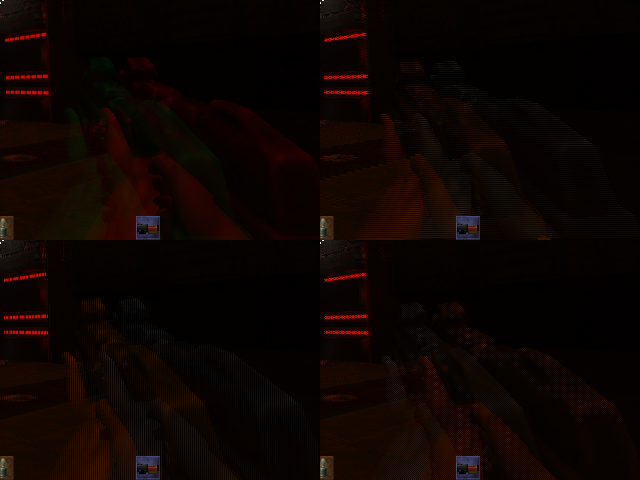Adding more stereoscopic modes to Quake II's OpenGL renderer
Thursday, 11th March 2010
Quake II's OpenGL renderer supports stereoscopic rendering providing you own a video card that has the requisite hardware and driver support ("quad-buffered" OpenGL rather than a single front and back buffer you have two front buffers and two back buffers, one for each eye). Not owning such a video card I decided to have a go at adding some other stereoscopic rendering modes that worked with regular hardware.

The four new stereoscopic rendering modes
The ability to enable or disable drawing with a particular colour component in OpenGL makes implementing an anaglyph mode very simple temporarily switch off red when drawing the view from one eye and temporarily switch off blue and green when drawing the view from the other to produce a final image that can be used with red/cyan 3D glasses. A new string console variable cl_stereo_anaglyph_colors can be amended to set the colour of your particular glasses, e.g. mg for magenta/green.
By drawing a mask to the stencil buffer before rendering one can easily add "interleaved" modes; there's the standard row interleaved format, but I've also added column and pixel interleaved formats.
It looks like the stereoscopic OpenGL code was started but not finished in Quake II; there were a number of odd bugs, such as the viewport position being changed instead of the camera position when drawing the left and right eye views (producing two views that were offset in 2D, not 3D). A snippet of code hints towards why this may be:
#if 0 // commented out until H3D pays us the money they owe us GL_DrawStereoPattern(); #endif
H3D manufactured a VGA adaptor for 3D glasses which relied on a special pattern being displayed on the screen to enable it and switch it to the correct mode rather than let the user do so. H3D went bust toward the end of 1998, so I guess id software never got their money and that function has been commented out ever since.
The new binaries can be downloaded from the Stereo Quake page, and the source can be found on Google Code.
